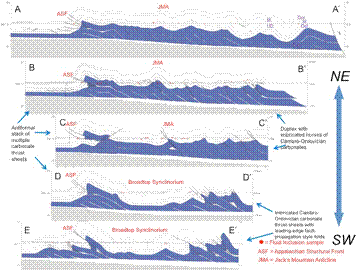Reports: UR851793-UR8: Fluid Evolution and Changes in Deformation Conditions During the Formation of the Central Appalachian Fold-and-Thrust Belt of Pennsylvania
Mark A. Evans, PhD, Central Connecticut State University
The analytical work has been divided into several tasks. One task involves examining the fluid inclusions and structural history of the Devonian shale sequence, including the Marcellus shale. In the past year, one student worked on this task, building on previous work that that will be published in AAPG Bulletin in November, 2014. The results of this part of the study greatly enhance the understanding of natural fracture formation in the Middle Devonian shale sequence. In particular, the fractures patterns and formation sequence do not fit the currently accepted model of two regional joint sets (J1 and J2). The earliest fractures in the region formed prior to folding, early during the Alleghenian orogeny as the rocks were buried into the oil generation window. They contain minerals that contain degraded hydrocarbon inclusions and basinal brine inclusions. The vein opening history is related to changes in fluid connectivity associated with 1) burial by over-thrusting and/or syntectonic depositional loading and/or 2) syndepositional folding uplift and erosion. The timing and conditions of fracture formation varies widely across the Valley and Ridge province. We will continue to investigate the fracture history of this Middle Devonian sequence in conjunction with other units. One student presented his poster presentations at NE GSA in March 2014.
Another task has been to construct a series of balanced cross sections around the central Pennsylvania salient. Evans is the primary on this task, but in the past year, one student also participated. We have now completed five regional cross sections (A-A' through E-E', Figures 1 and 2) and nine shorter sections across the Nittany anticlinorium (red lines, Figure 1). Currently, two students are assigned to cross section construction. On student is working on a sixth regional section to the east of section E-E' (Figure 1) and a second student is constructing a series of 10 short sections across the length of the Nittany anticline. Both students will be digitizing their sections into Midland Valley's 3D Move computer program and constructed a 3D retro-deformational model of the thrust system.
The structural geometry of the Valley and Ridge province changes markedly from the southwest to the northeast around the Pennsylvania salient (Figure 1 and 2). The sections show that the structural geometry of the fold-and-thrust belt varies markedly from the ~030o-striking southern
segment to ~060o-striking Juniata culmination. In the south, the eastern part of the belt is defined by a series of imbricated Cambro-Ordovician carbonate horses with leading-edge fault-propagation style folds that have a structural amplitude of 5 to 7 km. These give way to the Broadtop synclinorium in the central part of the belt, and then two additional carbonate horses with similar leading-edge folds that comprise the Wills Mt. anticlinorium toward the Appalachian Structural Front (ASF). These grade northward into an antiformal stack. In the central and eastern parts of the salient, the structural geometry is defined by a duplex with 10-11 imbricate horses of Cambro-Ordovician carbonates, that transition to an antiformal stack of two to three carbonate thrust sheets near the ASF and define the Nittany anticlinorium.
By integrating fluid inclusion microthermometric data that provides fluid trapping pressure temperature with the structural cross sections, we find that the regional variation in structural style cross the region may be related to the distribution of syn-tectonic loads during deformation. High syn-Alleghenian tectonic loads occur primarily above synclinoria and toward the SE and NE where basement thrust may have supplied the load. These loads would have driven the development of the duplex structures toward the hinterland. In turn, the growth of the duplex would have provided addition syntectonic load by erosion, further drive the development of the duplex. More work will be done to relate these restored loads to the development of the fold-and-thrust belt. Both Evans and a student presented separate posters at the National GSA meeting in Denver in October 2013. In March 2014, Evans gave a talk and the student presented a poster at the NE section meeting of the GSA.
The third task involves a fluid inclusions and stable isotopic study of calcite veins in the Siluro-Devonian and Cambro-Ordovician carbonate sequences. Host rock and vein samples were collected from sites across the southern Valley and Ridge province. Thin sections were described, fluid inclusion microthermometry done, and oxygen and carbon stable isotopes data run at the Yale Earth System Center for Stable Isotopic Studies. Results to date indicate that the calcite vein isotopic signature varies between vein sets, structural setting, and stratigraphic level. There are few generalization that can be made, suggesting that much of the control on fluids within the carbonate units is related by local fracture and fluid connectivity, which is in turn related to structural setting. Currently, one student is focusing on a more detailed analysis of isotopic data form the Siluro-Devonian sequence in the Nittany anticlinorium in southern Pennsylvania, and another student is focusing on the isotopic data from the Cambro-Ordovician sequence in the Nittany Anticline in central Pennsylvania. On student presented the results of this task at the NE GSA meeting in March 2014.
In the next year of the grant, we will continue to work on cross section construction, fluid inclusions microthermometry and stable isotope analyses.
Figure 1. Location map
Figure 2. Cross sections













